NC7WZ16P6X IC: Features, Applications and Datasheet
DUAL Buffer, Non-Inverting 1.65V~5.5V Push-Pull Buffers 7WZ Series 7WZ16 1 Bit per Element 6-TSSOP, SC-88, SOT-363









DUAL Buffer, Non-Inverting 1.65V~5.5V Push-Pull Buffers 7WZ Series 7WZ16 1 Bit per Element 6-TSSOP, SC-88, SOT-363
The ON Semiconductor NC7WZ16P6X is a dual buffer integrated circuit that belongs to the TinyLogic® UHS series. This article will introduce its features, applications and datasheet.
NC7WZ16P6X Description
The ON Semiconductor NC7WZ16P6X is a dual buffer integrated circuit that belongs to the TinyLogic® UHS series. It is designed to achieve ultra-high speed with high output drive while maintaining low static power dissipation over a very broad VCC operating range. The inputs and outputs are high impedance when VCC is 0V. The device is fabricated with advanced CMOS technology and is available in a 6-pin SC-70 package. It can operate with a supply voltage from 1.65V to 5.5V and a temperature range from -40°C to 125°C. It is suitable for applications that require fast switching, low power consumption, and small footprint, such as portable electronics, industrial automation systems, and automotive electronics.
NC7WZ16P6X Features
It is a dual buffer integrated circuit that belongs to the TinyLogic® UHS series.
It is designed to achieve ultra-high speed with high output drive while maintaining low static power dissipation over a very broad VCC operating range.
The inputs and outputs are high impedance when VCC is 0V.
The device is fabricated with advanced CMOS technology and is available in a 6-pin SC-70 package.
It can operate with a supply voltage from 1.65V to 5.5V and a temperature range from -40°C to 125°C.
It is suitable for applications that require fast switching, low power consumption, and small footprint, such as portable electronics, industrial automation systems, and automotive electronics
Specifications
- TypeParameter
- Lifecycle Status
Lifecycle Status refers to the current stage of an electronic component in its product life cycle, indicating whether it is active, obsolete, or transitioning between these states. An active status means the component is in production and available for purchase. An obsolete status indicates that the component is no longer being manufactured or supported, and manufacturers typically provide a limited time frame for support. Understanding the lifecycle status is crucial for design engineers to ensure continuity and reliability in their projects.
ACTIVE (Last Updated: 2 days ago) - Factory Lead Time13 Weeks
- Contact Plating
Contact plating (finish) provides corrosion protection for base metals and optimizes the mechanical and electrical properties of the contact interfaces.
Tin - Mount
In electronic components, the term "Mount" typically refers to the method or process of physically attaching or fixing a component onto a circuit board or other electronic device. This can involve soldering, adhesive bonding, or other techniques to secure the component in place. The mounting process is crucial for ensuring proper electrical connections and mechanical stability within the electronic system. Different components may have specific mounting requirements based on their size, shape, and function, and manufacturers provide guidelines for proper mounting procedures to ensure optimal performance and reliability of the electronic device.
Surface Mount - Mounting Type
The "Mounting Type" in electronic components refers to the method used to attach or connect a component to a circuit board or other substrate, such as through-hole, surface-mount, or panel mount.
Surface Mount - Package / Case
refers to the protective housing that encases an electronic component, providing mechanical support, electrical connections, and thermal management.
6-TSSOP, SC-88, SOT-363 - Number of Pins6
- Weight28mg
- Operating Temperature
The operating temperature is the range of ambient temperature within which a power supply, or any other electrical equipment, operate in. This ranges from a minimum operating temperature, to a peak or maximum operating temperature, outside which, the power supply may fail.
-40°C~125°C TA - Packaging
Semiconductor package is a carrier / shell used to contain and cover one or more semiconductor components or integrated circuits. The material of the shell can be metal, plastic, glass or ceramic.
Tape & Reel (TR) - Series
In electronic components, the "Series" refers to a group of products that share similar characteristics, designs, or functionalities, often produced by the same manufacturer. These components within a series typically have common specifications but may vary in terms of voltage, power, or packaging to meet different application needs. The series name helps identify and differentiate between various product lines within a manufacturer's catalog.
7WZ - Published2010
- JESD-609 Code
The "JESD-609 Code" in electronic components refers to a standardized marking code that indicates the lead-free solder composition and finish of electronic components for compliance with environmental regulations.
e4 - Pbfree Code
The "Pbfree Code" parameter in electronic components refers to the code or marking used to indicate that the component is lead-free. Lead (Pb) is a toxic substance that has been widely used in electronic components for many years, but due to environmental concerns, there has been a shift towards lead-free alternatives. The Pbfree Code helps manufacturers and users easily identify components that do not contain lead, ensuring compliance with regulations and promoting environmentally friendly practices. It is important to pay attention to the Pbfree Code when selecting electronic components to ensure they meet the necessary requirements for lead-free applications.
yes - Part Status
Parts can have many statuses as they progress through the configuration, analysis, review, and approval stages.
Active - Moisture Sensitivity Level (MSL)
Moisture Sensitivity Level (MSL) is a standardized rating that indicates the susceptibility of electronic components, particularly semiconductors, to moisture-induced damage during storage and the soldering process, defining the allowable exposure time to ambient conditions before they require special handling or baking to prevent failures
1 (Unlimited) - Number of Terminations6
- Termination
Termination in electronic components refers to the practice of matching the impedance of a circuit to prevent signal reflections and ensure maximum power transfer. It involves the use of resistors or other components at the end of transmission lines or connections. Proper termination is crucial in high-frequency applications to maintain signal integrity and reduce noise.
SMD/SMT - ECCN Code
An ECCN (Export Control Classification Number) is an alphanumeric code used by the U.S. Bureau of Industry and Security to identify and categorize electronic components and other dual-use items that may require an export license based on their technical characteristics and potential for military use.
EAR99 - Terminal Finish
Terminal Finish refers to the surface treatment applied to the terminals or leads of electronic components to enhance their performance and longevity. It can improve solderability, corrosion resistance, and overall reliability of the connection in electronic assemblies. Common finishes include nickel, gold, and tin, each possessing distinct properties suitable for various applications. The choice of terminal finish can significantly impact the durability and effectiveness of electronic devices.
Nickel/Palladium/Gold (Ni/Pd/Au) - Packing Method
The packing method in electronic components refers to the technique used to package and protect the component during shipping and handling. It encompasses various forms including tape and reel, tray, tube, or bulk packaging, each suited for different types of components and manufacturing processes. The choice of packing method can affect the ease of handling, storage, and the efficiency of assembly in automated processes. Additionally, it plays a crucial role in ensuring the reliability and integrity of the components until they are used in electronic devices.
TAPE AND REEL - Max Power Dissipation
The maximum power that the MOSFET can dissipate continuously under the specified thermal conditions.
180mW - Voltage - Supply
Voltage - Supply refers to the range of voltage levels that an electronic component or circuit is designed to operate with. It indicates the minimum and maximum supply voltage that can be applied for the device to function properly. Providing supply voltages outside this range can lead to malfunction, damage, or reduced performance. This parameter is critical for ensuring compatibility between different components in a circuit.
1.65V~5.5V - Terminal Position
In electronic components, the term "Terminal Position" refers to the physical location of the connection points on the component where external electrical connections can be made. These connection points, known as terminals, are typically used to attach wires, leads, or other components to the main body of the electronic component. The terminal position is important for ensuring proper connectivity and functionality of the component within a circuit. It is often specified in technical datasheets or component specifications to help designers and engineers understand how to properly integrate the component into their circuit designs.
DUAL - Terminal Form
Occurring at or forming the end of a series, succession, or the like; closing; concluding.
GULL WING - Number of Functions2
- Supply Voltage
Supply voltage refers to the electrical potential difference provided to an electronic component or circuit. It is crucial for the proper operation of devices, as it powers their functions and determines performance characteristics. The supply voltage must be within specified limits to ensure reliability and prevent damage to components. Different electronic devices have specific supply voltage requirements, which can vary widely depending on their design and intended application.
1.8V - Base Part Number
The "Base Part Number" (BPN) in electronic components serves a similar purpose to the "Base Product Number." It refers to the primary identifier for a component that captures the essential characteristics shared by a group of similar components. The BPN provides a fundamental way to reference a family or series of components without specifying all the variations and specific details.
7WZ16 - Output Type
The "Output Type" parameter in electronic components refers to the type of signal or data that is produced by the component as an output. This parameter specifies the nature of the output signal, such as analog or digital, and can also include details about the voltage levels, current levels, frequency, and other characteristics of the output signal. Understanding the output type of a component is crucial for ensuring compatibility with other components in a circuit or system, as well as for determining how the output signal can be utilized or processed further. In summary, the output type parameter provides essential information about the nature of the signal that is generated by the electronic component as its output.
Push-Pull - Polarity
In electronic components, polarity refers to the orientation or direction in which the component must be connected in a circuit to function properly. Components such as diodes, capacitors, and LEDs have polarity markings to indicate which terminal should be connected to the positive or negative side of the circuit. Connecting a component with incorrect polarity can lead to malfunction or damage. It is important to pay attention to polarity markings and follow the manufacturer's instructions to ensure proper operation of electronic components.
Non-Inverting - Supply Voltage-Max (Vsup)
The parameter "Supply Voltage-Max (Vsup)" in electronic components refers to the maximum voltage that can be safely applied to the component without causing damage. It is an important specification to consider when designing or using electronic circuits to ensure the component operates within its safe operating limits. Exceeding the maximum supply voltage can lead to overheating, component failure, or even permanent damage. It is crucial to adhere to the specified maximum supply voltage to ensure the reliable and safe operation of the electronic component.
5.5V - Power Supplies
an electronic circuit that converts the voltage of an alternating current (AC) into a direct current (DC) voltage.?
3.3V - Number of Channels2
- Load Capacitance
the amount of capacitance measured or computed across the crystal terminals on the PCB. Frequency Tolerance. Frequency tolerance refers to the allowable deviation from nominal, in parts per million (PPM), at a specific temperature, usually +25°C.
50pF - Propagation Delay
the flight time of packets over the transmission link and is limited by the speed of light.
3.8 ns - Quiescent Current
The quiescent current is defined as the current level in the amplifier when it is producing an output of zero.
1μA - Turn On Delay Time
Turn-on delay, td(on), is the time taken to charge the input capacitance of the device before drain current conduction can start.
10.6 ns - Family
In electronic components, the parameter "Family" typically refers to a categorization or classification system used to group similar components together based on their characteristics, functions, or applications. This classification helps users easily identify and select components that meet their specific requirements. The "Family" parameter can include various subcategories such as resistors, capacitors, diodes, transistors, integrated circuits, and more. Understanding the "Family" of an electronic component can provide valuable information about its compatibility, performance specifications, and potential uses within a circuit or system. It is important to consider the "Family" parameter when designing or troubleshooting electronic circuits to ensure proper functionality and compatibility with other components.
LVC/LCX/Z - Logic Function
In electronic components, the term "Logic Function" refers to the specific operation or behavior of a component based on its input signals. It describes how the component processes the input signals to produce the desired output. Logic functions are fundamental to digital circuits and are used to perform logical operations such as AND, OR, NOT, and XOR.Each electronic component, such as logic gates or flip-flops, is designed to perform a specific logic function based on its internal circuitry. By understanding the logic function of a component, engineers can design and analyze complex digital systems to ensure proper functionality and performance. Different logic functions can be combined to create more complex operations, allowing for the creation of sophisticated digital devices and systems.
Buffer, Inverting - Logic Type
Logic Type in electronic components refers to the classification of circuits based on the logical operations they perform. It includes types such as AND, OR, NOT, NAND, NOR, XOR, and XNOR, each defining the relationship between binary inputs and outputs. The logic type determines how the inputs affect the output state based on specific rules of Boolean algebra. This classification is crucial for designing digital circuits and systems, enabling engineers to select appropriate components for desired functionalities.
Buffer, Non-Inverting - Number of Bits per Element1
- Schmitt Trigger
A Schmitt Trigger is a type of comparator circuit commonly used in electronics to convert an analog input signal into a digital output signal. It has hysteresis, which means that the output switches at different voltage levels depending on whether the input is rising or falling. This hysteresis helps to eliminate noise and provide a more stable output signal. Schmitt Triggers are often used in applications where noise immunity and signal conditioning are important, such as in signal processing, waveform shaping, and digital logic circuits.
NO - Number of Output Lines2
- Height1mm
- Length2mm
- Width1.25mm
- REACH SVHC
The parameter "REACH SVHC" in electronic components refers to the compliance with the Registration, Evaluation, Authorization, and Restriction of Chemicals (REACH) regulation regarding Substances of Very High Concern (SVHC). SVHCs are substances that may have serious effects on human health or the environment, and their use is regulated under REACH to ensure their safe handling and minimize their impact.Manufacturers of electronic components need to declare if their products contain any SVHCs above a certain threshold concentration and provide information on the safe use of these substances. This information allows customers to make informed decisions about the potential risks associated with using the components and take appropriate measures to mitigate any hazards.Ensuring compliance with REACH SVHC requirements is essential for electronics manufacturers to meet regulatory standards, protect human health and the environment, and maintain transparency in their supply chain. It also demonstrates a commitment to sustainability and responsible manufacturing practices in the electronics industry.
No SVHC - Radiation Hardening
Radiation hardening is the process of making electronic components and circuits resistant to damage or malfunction caused by high levels of ionizing radiation, especially for environments in outer space (especially beyond the low Earth orbit), around nuclear reactors and particle accelerators, or during nuclear accidents or nuclear warfare.
No - RoHS Status
RoHS means “Restriction of Certain Hazardous Substances” in the “Hazardous Substances Directive” in electrical and electronic equipment.
ROHS3 Compliant - Lead Free
Lead Free is a term used to describe electronic components that do not contain lead as part of their composition. Lead is a toxic material that can have harmful effects on human health and the environment, so the electronics industry has been moving towards lead-free components to reduce these risks. Lead-free components are typically made using alternative materials such as silver, copper, and tin. Manufacturers must comply with regulations such as the Restriction of Hazardous Substances (RoHS) directive to ensure that their products are lead-free and environmentally friendly.
Lead Free
NC7WZ16P6X Pinout
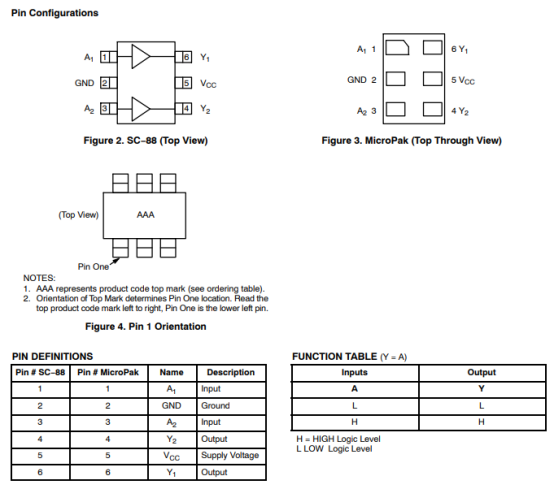
NC7WZ16P6X CAD Model
Symbol
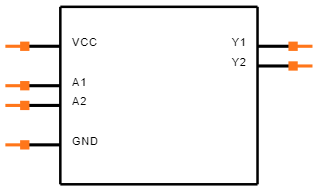
Footprint
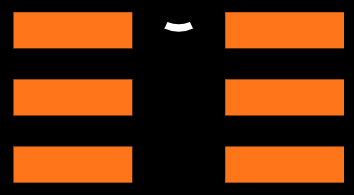
3D Model
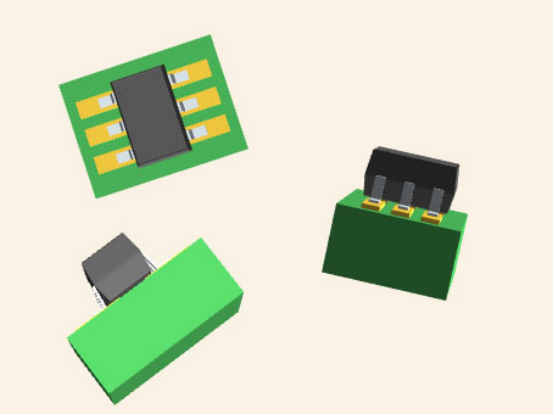
NC7WZ16P6X Alternatives
Part Number | Description | Manufacturer |
V62/06659-01XE | Enhanced product 2-ch, 1.65-V to 5.5-V buffers 6-SC70 -55 to 125 | Texas Instruments |
NC7WZ16P6_NL | Buffer, LVC/LCX/Z Series, 2-Func, 1-Input, CMOS, PDSO6, 1.25 MM, LEAD FREE, EIAJ, SC-88, SC-70, 6 PIN | Fairchild Semiconductor Corporation |
NL27WZ16DFT2 | 27WZ SERIES, DUAL 1-INPUT NON-INVERT GATE, PDSO6, SC-88, SC-70, SOT-363, 6 PIN | onsemi |
NC7WZ16P6X_NL | Buffer, LVC/LCX/Z Series, 2-Func, 1-Input, CMOS, PDSO6, 1.25 MM, ROHS COMPLIANT, EIAJ, SC-88A, SC-70, 6 PIN | Fairchild Semiconductor Corporation |
NC7WZ16P6X Applications
Portable electronics: The device can be used to buffer signals from sensors, microcontrollers, or other devices that operate with low voltage and low current. The device can also provide high output drive to drive LEDs, buzzers, or other indicators. The device can operate with a wide range of supply voltage from 1.65V to 5.5V, which makes it compatible with different battery types. The device also has high impedance inputs and outputs when VCC is 0V, which reduces power consumption when the device is not in use.
Industrial automation systems: The device can be used to buffer signals from sensors, switches, or other inputs that may have different voltage levels or noise characteristics. The device can also provide high output drive to drive relays, solenoids, or other actuators. The device can tolerate over-voltage inputs, which facilitates 5V to 3V translation. The device also has a wide operating temperature range from -40°C to 125°C, which makes it suitable for harsh environments.
Automotive electronics: The device can be used to buffer signals from sensors, cameras, or other devices that operate with low voltage and low current. The device can also provide high output drive to drive LEDs, displays, or other indicators. The device can operate with a wide range of supply voltage from 1.65V to 5.5V, which makes it compatible with different battery types. The device also has a wide operating temperature range from -40°C to 125°C, which makes it suitable for extreme conditions.
NC7WZ16P6X Manufacturer
ON Semiconductor is a global leader in semiconductor-based solutions for various markets and applications. It offers a wide range of products, such as discrete and power modules, power management, signal conditioning and control, sensors, motor control, custom and ASSP, interfaces, timing, logic and memory. It focuses on driving intelligent power and sensing technologies to create a more sustainable ecosystem for future generations. It has over 30,000 employees worldwide and serves customers in more than 100 countries. It was founded in 1999 as a spin-off of Motorola’s Semiconductor Products Sector and is headquartered in Phoenix, Arizona.
Parts with Similar Specs
- ImagePart NumberManufacturerPackage / CaseNumber of PinsLogic FunctionPropagation DelaySupply VoltageQuiescent CurrentTechnologyTerminal FinishView Compare
NC7WZ16P6X
6-TSSOP, SC-88, SOT-363
6
Buffer, Inverting
3.8 ns
1.8 V
1 μA
CMOS
Nickel/Palladium/Gold (Ni/Pd/Au)
6-TSSOP, SC-88, SOT-363
6
Buffer, Schmitt Trigger
8.3 ns
1.8 V
1 μA
CMOS
Nickel/Palladium/Gold (Ni/Pd/Au)
6-TSSOP, SC-88, SOT-363
6
Buffer, Inverter, Schmitt Trigger
4.9 ns
1.8 V
1 μA
CMOS
Nickel/Palladium/Gold (Ni/Pd/Au)
6-TSSOP, SC-88, SOT-363
6
Buffer, Inverting
12.6 ns
1.8 V
10 μA
CMOS
Nickel/Palladium/Gold (Ni/Pd/Au)
5-TSSOP, SC-70-5, SOT-353
5
Buffer, Inverting
4.1 ns
3.3 V
1 μA
CMOS
Nickel/Palladium/Gold (Ni/Pd/Au)
Datasheet PDF
- PCN Design/Specification :
- Datasheets :
NC7WZ16P6X-ON-Semiconductor-datasheet-137256437.pdf
NC7WZ16P6X-ON-Semiconductor-datasheet-86692671.pdf
NC7WZ16P6X-ON-Semiconductor-datasheet-78861903.pdf
NC7WZ16P6X-ON-Semiconductor-datasheet-85592131.pdf
NC7WZ16P6X-Fairchild-Semiconductor-datasheet-67809941.pdf
NC7WZ16P6X-ON-Semiconductor-datasheet-11778314.pdf
NC7WZ16P6X.-Fairchild-Semiconductor-datasheet-7575100.pdf
NC7WZ16P6X.-Fairchild-Semiconductor-datasheet-52098.pdf
pid_7551165_nc7wz16p6x-on-semiconductor-datasheet-137256437.pdf
- PCN Assembly/Origin :
- Environmental Information :
- PCN Packaging :
- ReachStatement :
What is the NC7WZ16P6X?
The NC7WZ16P6X is a dual buffer integrated circuit that belongs to the TinyLogic® UHS series. It is designed to achieve ultra-high speed with high output drive while maintaining low static power dissipation over a very broad VCC operating range. The inputs and outputs are high impedance when VCC is 0V.
What are the features of the NC7WZ16P6X?
Some of the features of the NC7WZ16P6X are: Ultra-high speed: tPD = 2.4 ns (Typical) into 50 pF at 5 V VCC High output drive: ±24 mA at 3 V VCC Broad VCC operating range: 1.65 V to 5.5 V Power down high-impedance inputs / outputs Over-voltage tolerance inputs facilitate 5 V to 3 V translation Proprietary noise / EMI reduction circuitry Ultra-small MicroPak and SC-88 packages
What are the applications of the NC7WZ16P6X?
The NC7WZ16P6X can be used for various applications that require fast switching, low power consumption, and small footprint. Some examples of such applications are: Portable electronics: The device can be used to buffer signals from sensors, microcontrollers, or other devices that operate with low voltage and low current. The device can also provide high output drive to drive LEDs, buzzers, or other indicators. The device can operate with a wide range of supply voltage from 1.65 V to 5.5 V, which makes it compatible with different battery types. The device also has high impedance inputs and outputs when VCC is 0 V, which reduces power consumption when the device is not in use. Industrial automation systems: The device can be used to buffer signals from sensors, switches, or other inputs that may have different voltage levels or noise characteristics. The device can also provide high output drive to drive relays, solenoids, or other actuators. The device can tolerate over-voltage inputs, which facilitates 5 V to 3 V translation. The device also has a wide operating temperature range from -40°C to 125°C, which makes it suitable for harsh environments. Automotive electronics: The device can be used to buffer signals from sensors, cameras, or other devices that operate with low voltage and low current. The device can also provide high output drive to drive LEDs, displays, or other indicators. The device can operate with a wide range of supply voltage from 1.65 V to 5.5 V, which makes it compatible with different battery types. The device also has a wide operating temperature range from -40°C to 125°C, which makes it suitable for extreme conditions.
 74HC244 Driver IC: Pinout, Alterntaive and Price
74HC244 Driver IC: Pinout, Alterntaive and Price30 August 20212907
 KSZ8081MNX Transceiver: Pinout, Equivalent and Datasheet
KSZ8081MNX Transceiver: Pinout, Equivalent and Datasheet24 January 20222490
 CR2025 Battery: Features, Pinout, and Datasheet
CR2025 Battery: Features, Pinout, and Datasheet30 September 20212967
 Microchip PIC32MX130F064DVPT Technical Datasheet
Microchip PIC32MX130F064DVPT Technical Datasheet29 February 2024100
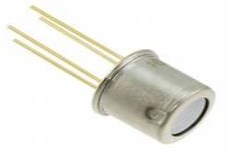 MLX90614 Infra Red Thermometer: Pinout, Datasheet and Applications
MLX90614 Infra Red Thermometer: Pinout, Datasheet and Applications30 July 20215518
![HT7333 How to use a HT7333 IC?[Video]](https://res.utmel.com/Images/Article/882d6c87-9c81-4515-b682-29cdfa70cf1a.png) HT7333 How to use a HT7333 IC?[Video]
HT7333 How to use a HT7333 IC?[Video]18 April 20223532
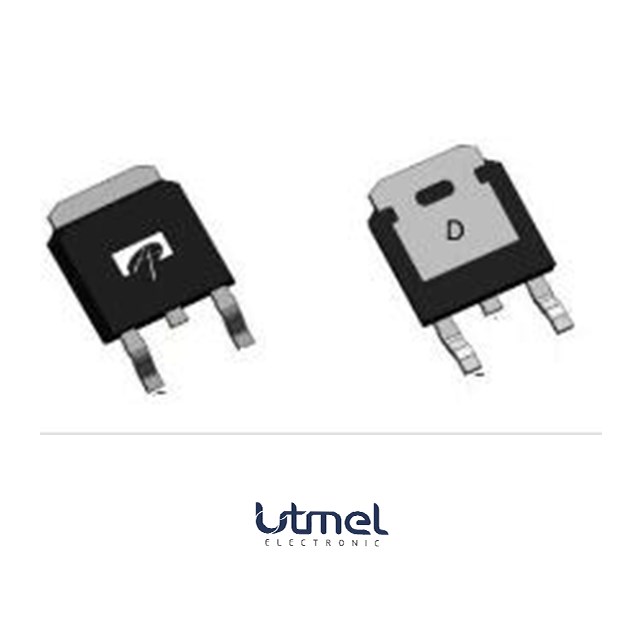 AOD4185:P-Channel Enhancement Mode Field Effect Transistor
AOD4185:P-Channel Enhancement Mode Field Effect Transistor09 March 20221126
 STMicroelectronics LIS3MDLTR Troubleshooting Guide
STMicroelectronics LIS3MDLTR Troubleshooting Guide20 August 2025239
 What is a Decoupling Capacitor?
What is a Decoupling Capacitor?23 October 202511369
 Introduction of 55 ADC and DAC Commonly Used Terms
Introduction of 55 ADC and DAC Commonly Used Terms02 December 20214749
 Working Principle and Types of Throttle Position Sensor
Working Principle and Types of Throttle Position Sensor01 April 202431497
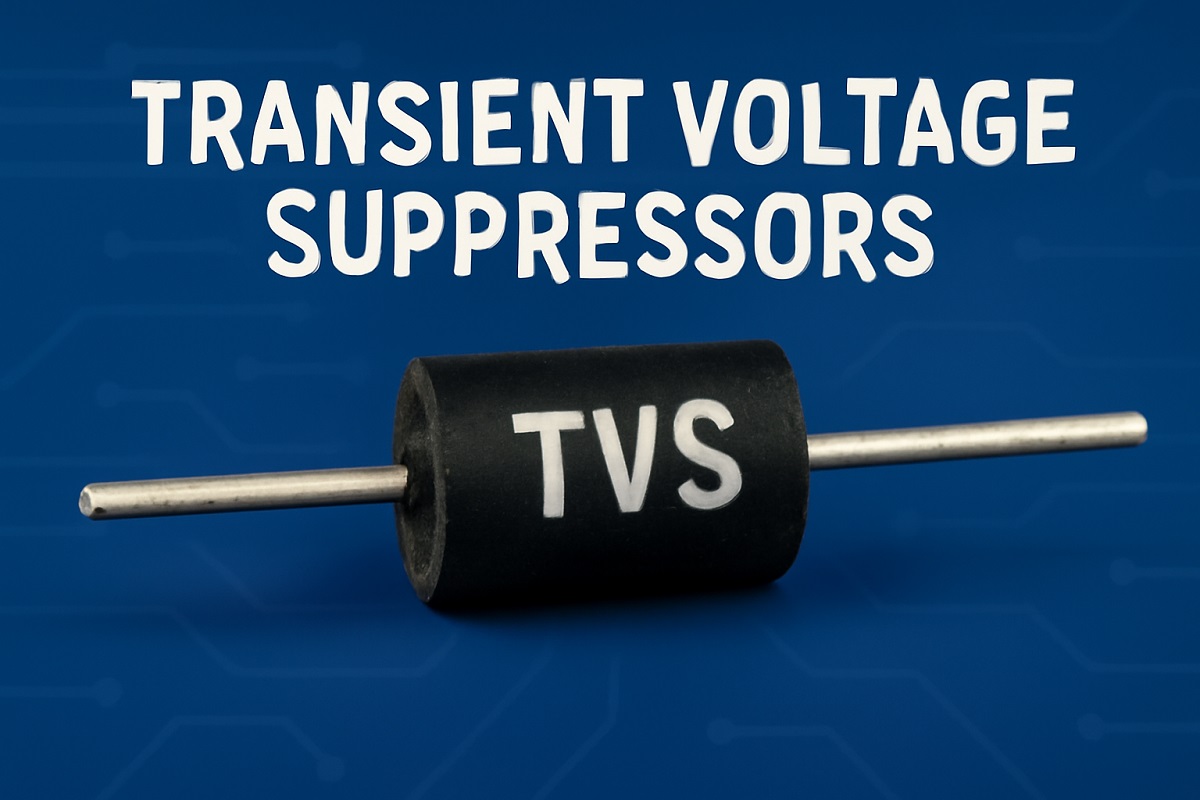 Assessing the Effectiveness of Transient Voltage Suppressors in Modern Electronics
Assessing the Effectiveness of Transient Voltage Suppressors in Modern Electronics05 June 2025217
 How to Increase Laptop Battery Life
How to Increase Laptop Battery Life03 July 20212902
 Semiconductor Industry's Water Risk Underpriced, Warn Fund Managers
Semiconductor Industry's Water Risk Underpriced, Warn Fund Managers14 September 20232250
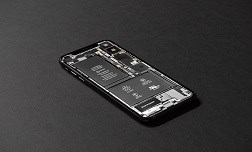 Reverse Voltage Protection for Battery Chargers
Reverse Voltage Protection for Battery Chargers29 March 20223857
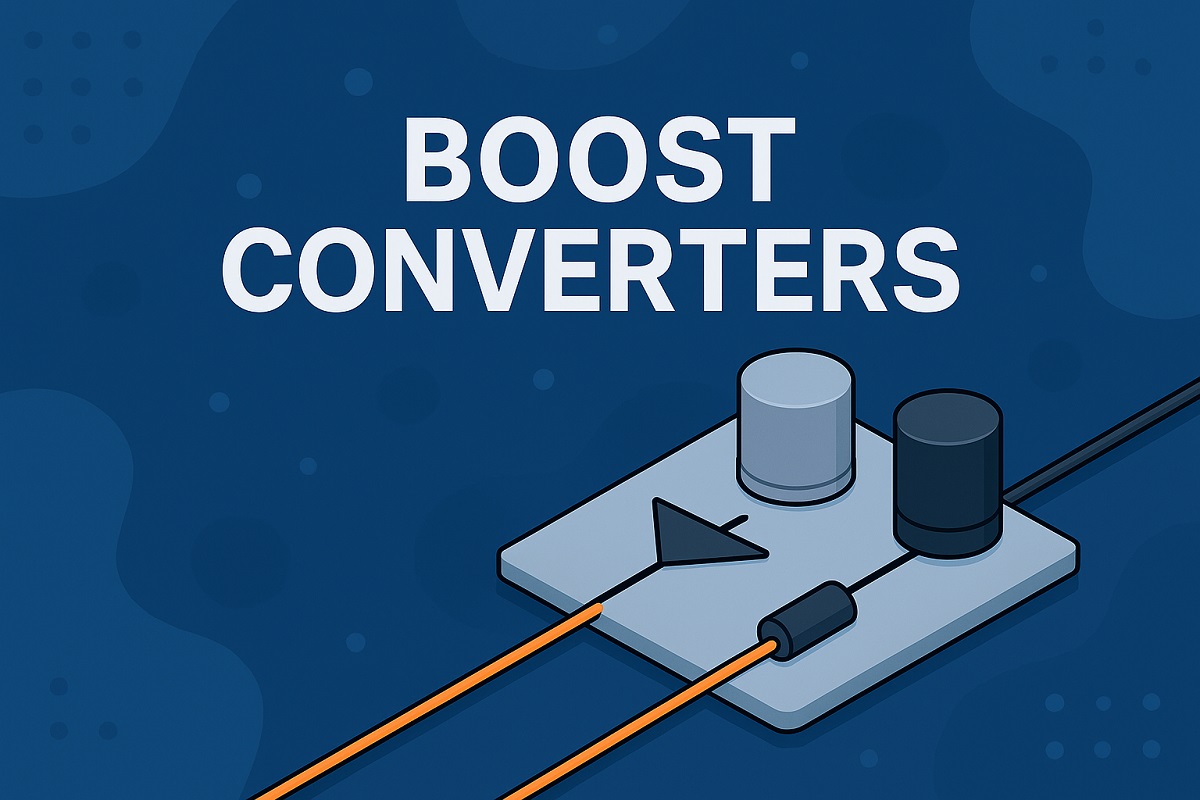 How to Pick the Perfect Boost Converter for Your Needs
How to Pick the Perfect Boost Converter for Your Needs07 June 2025639
ON Semiconductor
In Stock: 3000
United States
China
Canada
Japan
Russia
Germany
United Kingdom
Singapore
Italy
Hong Kong(China)
Taiwan(China)
France
Korea
Mexico
Netherlands
Malaysia
Austria
Spain
Switzerland
Poland
Thailand
Vietnam
India
United Arab Emirates
Afghanistan
Åland Islands
Albania
Algeria
American Samoa
Andorra
Angola
Anguilla
Antigua & Barbuda
Argentina
Armenia
Aruba
Australia
Azerbaijan
Bahamas
Bahrain
Bangladesh
Barbados
Belarus
Belgium
Belize
Benin
Bermuda
Bhutan
Bolivia
Bonaire, Sint Eustatius and Saba
Bosnia & Herzegovina
Botswana
Brazil
British Indian Ocean Territory
British Virgin Islands
Brunei
Bulgaria
Burkina Faso
Burundi
Cabo Verde
Cambodia
Cameroon
Cayman Islands
Central African Republic
Chad
Chile
Christmas Island
Cocos (Keeling) Islands
Colombia
Comoros
Congo
Congo (DRC)
Cook Islands
Costa Rica
Côte d’Ivoire
Croatia
Cuba
Curaçao
Cyprus
Czechia
Denmark
Djibouti
Dominica
Dominican Republic
Ecuador
Egypt
El Salvador
Equatorial Guinea
Eritrea
Estonia
Eswatini
Ethiopia
Falkland Islands
Faroe Islands
Fiji
Finland
French Guiana
French Polynesia
Gabon
Gambia
Georgia
Ghana
Gibraltar
Greece
Greenland
Grenada
Guadeloupe
Guam
Guatemala
Guernsey
Guinea
Guinea-Bissau
Guyana
Haiti
Honduras
Hungary
Iceland
Indonesia
Iran
Iraq
Ireland
Isle of Man
Israel
Jamaica
Jersey
Jordan
Kazakhstan
Kenya
Kiribati
Kosovo
Kuwait
Kyrgyzstan
Laos
Latvia
Lebanon
Lesotho
Liberia
Libya
Liechtenstein
Lithuania
Luxembourg
Macao(China)
Madagascar
Malawi
Maldives
Mali
Malta
Marshall Islands
Martinique
Mauritania
Mauritius
Mayotte
Micronesia
Moldova
Monaco
Mongolia
Montenegro
Montserrat
Morocco
Mozambique
Myanmar
Namibia
Nauru
Nepal
New Caledonia
New Zealand
Nicaragua
Niger
Nigeria
Niue
Norfolk Island
North Korea
North Macedonia
Northern Mariana Islands
Norway
Oman
Pakistan
Palau
Palestinian Authority
Panama
Papua New Guinea
Paraguay
Peru
Philippines
Pitcairn Islands
Portugal
Puerto Rico
Qatar
Réunion
Romania
Rwanda
Samoa
San Marino
São Tomé & Príncipe
Saudi Arabia
Senegal
Serbia
Seychelles
Sierra Leone
Sint Maarten
Slovakia
Slovenia
Solomon Islands
Somalia
South Africa
South Sudan
Sri Lanka
St Helena, Ascension, Tristan da Cunha
St. Barthélemy
St. Kitts & Nevis
St. Lucia
St. Martin
St. Pierre & Miquelon
St. Vincent & Grenadines
Sudan
Suriname
Svalbard & Jan Mayen
Sweden
Syria
Tajikistan
Tanzania
Timor-Leste
Togo
Tokelau
Tonga
Trinidad & Tobago
Tunisia
Turkey
Turkmenistan
Turks & Caicos Islands
Tuvalu
U.S. Outlying Islands
U.S. Virgin Islands
Uganda
Ukraine
Uruguay
Uzbekistan
Vanuatu
Vatican City
Venezuela
Wallis & Futuna
Yemen
Zambia
Zimbabwe






